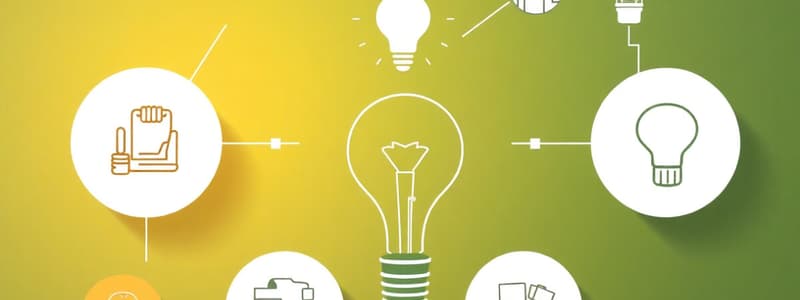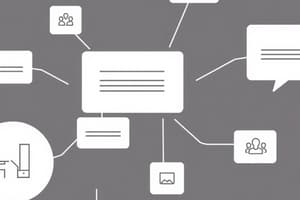Podcast
Questions and Answers
What foundational principle underlies design thinking?
What foundational principle underlies design thinking?
- An emphasis on minimizing costs.
- A user-centered approach. (correct)
- A reliance on quantitative data alone.
- A focus on technological advancements.
Which of the following is NOT a key stage in the Design Thinking Framework?
Which of the following is NOT a key stage in the Design Thinking Framework?
- Test
- Define
- Delegate (correct)
- Empathize
Why is the 'Empathize' stage crucial in design thinking?
Why is the 'Empathize' stage crucial in design thinking?
- To generate as many ideas as possible.
- To quickly create a prototype for testing.
- To gain a deep understanding of the user's needs and perspectives. (correct)
- To define the project's budget and timeline.
What is the primary goal of the 'Define' stage in design thinking?
What is the primary goal of the 'Define' stage in design thinking?
In the 'Ideate' stage, what approach is most effective for generating a broad range of ideas?
In the 'Ideate' stage, what approach is most effective for generating a broad range of ideas?
What is the main purpose of prototyping in the design thinking process?
What is the main purpose of prototyping in the design thinking process?
Why is the 'Test' stage important in the design thinking process?
Why is the 'Test' stage important in the design thinking process?
What does the 'Implement' stage of design thinking primarily focus on?
What does the 'Implement' stage of design thinking primarily focus on?
Design thinking emphasizes iteration. What does this mean for the design process?
Design thinking emphasizes iteration. What does this mean for the design process?
Which of the following best describes a key principle of design thinking?
Which of the following best describes a key principle of design thinking?
How did Airbnb use design thinking concepts in their early stages
How did Airbnb use design thinking concepts in their early stages
Which benefit is commonly associated with design thinking?
Which benefit is commonly associated with design thinking?
In the Stanford d.school's approach to improve a pediatric patient's experience in hospitals, what was the primary focus during the 'Define' stage?
In the Stanford d.school's approach to improve a pediatric patient's experience in hospitals, what was the primary focus during the 'Define' stage?
Which challenge is commonly faced when implementing design thinking?
Which challenge is commonly faced when implementing design thinking?
Which of the following is emphasized as central to the design thinking process?
Which of the following is emphasized as central to the design thinking process?
According to the Design Process that was presented, what's a description of the process?
According to the Design Process that was presented, what's a description of the process?
What benefit can come from following the design process?
What benefit can come from following the design process?
Which sequence accurately represents the key stages in the Design Process, as outlined in the material?
Which sequence accurately represents the key stages in the Design Process, as outlined in the material?
What is the ultimate goal of the Double Diamond Design Process?
What is the ultimate goal of the Double Diamond Design Process?
The 'Discover' phase of the Double Diamond Design Process is about?
The 'Discover' phase of the Double Diamond Design Process is about?
During the "Define" phase of the Double Diamond Design Process, you should...
During the "Define" phase of the Double Diamond Design Process, you should...
During the "Develop" phase, what processes could be implemented?
During the "Develop" phase, what processes could be implemented?
What is the purpose of the 'Deliver' phase in the Double Diamond Design Process?
What is the purpose of the 'Deliver' phase in the Double Diamond Design Process?
Which of the following is a 'Dimension of Interaction Design' according to the text?
Which of the following is a 'Dimension of Interaction Design' according to the text?
What are Interaction Design Frameworks?
What are Interaction Design Frameworks?
In the early stages, what strategy did Airbnb use?
In the early stages, what strategy did Airbnb use?
What happened after Airbnb used the Design Thinking strategy?
What happened after Airbnb used the Design Thinking strategy?
What can be said about design thinking vs design process?
What can be said about design thinking vs design process?
Which statement correctly differentiates between design thinking and the design process?
Which statement correctly differentiates between design thinking and the design process?
Which of the statements correctly explains the difference between the Double Diamond Design Process and Interaction Design Frameworks?
Which of the statements correctly explains the difference between the Double Diamond Design Process and Interaction Design Frameworks?
How did Spotify use Design Process concepts?
How did Spotify use Design Process concepts?
Why is it essential for design thinking to iterate and test?
Why is it essential for design thinking to iterate and test?
What does a robust Interaction Design Framework guarantee?
What does a robust Interaction Design Framework guarantee?
If you are trying to find a way to emphasize the process of making an effective product, what should you refer to?
If you are trying to find a way to emphasize the process of making an effective product, what should you refer to?
Aligning project stakeholders is vital, what should you do to better the outcome?
Aligning project stakeholders is vital, what should you do to better the outcome?
Which of the following best exemplifies the 'Human-Centered' principle of design thinking?
Which of the following best exemplifies the 'Human-Centered' principle of design thinking?
When using heat maps, what are they used for?
When using heat maps, what are they used for?
What does the acronym POV stand for?
What does the acronym POV stand for?
What does High-Fidelity Prototyping do?
What does High-Fidelity Prototyping do?
Flashcards
What is Design Thinking?
What is Design Thinking?
A user-centered, iterative process for problem-solving that focuses on empathy, creativity, and experimentation.
Empathize
Empathize
Understand users & their needs.
Define
Define
Clearly articulate the problem.
Ideate
Ideate
Signup and view all the flashcards
Prototype
Prototype
Signup and view all the flashcards
Test
Test
Signup and view all the flashcards
Implement
Implement
Signup and view all the flashcards
Design Process Definition
Design Process Definition
Signup and view all the flashcards
Design Process Importance
Design Process Importance
Signup and view all the flashcards
Design Process Key Stages
Design Process Key Stages
Signup and view all the flashcards
Double Diamond Design Process
Double Diamond Design Process
Signup and view all the flashcards
Discover Phase Purpose
Discover Phase Purpose
Signup and view all the flashcards
Discover Phase Activities
Discover Phase Activities
Signup and view all the flashcards
Define Phase Purpose
Define Phase Purpose
Signup and view all the flashcards
Define Phase Activities
Define Phase Activities
Signup and view all the flashcards
Develop Phase Purpose
Develop Phase Purpose
Signup and view all the flashcards
Develop Phase Activities
Develop Phase Activities
Signup and view all the flashcards
Deliver Phase Purpose
Deliver Phase Purpose
Signup and view all the flashcards
Deliver Phase Activities
Deliver Phase Activities
Signup and view all the flashcards
Interaction Design Dimensions
Interaction Design Dimensions
Signup and view all the flashcards
Double Diamond vs. Interaction Design Similarities
Double Diamond vs. Interaction Design Similarities
Signup and view all the flashcards
Double Diamond vs. Interaction Design Differences
Double Diamond vs. Interaction Design Differences
Signup and view all the flashcards
Design Process
Design Process
Signup and view all the flashcards
Design Thinking
Design Thinking
Signup and view all the flashcards
Study Notes
Introduction to Design Thinking
- Design thinking is a user-centered, iterative approach to problem-solving that focuses on empathy, creativity, and experimentation
- Design thinking encourages innovation and creative solutions and prioritizes understanding and solving the right problem
- Tim Brown, CEO of IDEO, defines design thinking as an approach to innovation that integrates the needs of people, technological possibilities, and business requirements
Design Thinking Framework
- The design thinking framework has six key stages
- Stage 1: Empathize involves understanding the users and their needs
- Stage 2: Define consists of clearly articulating the problem
- Stage 3: Ideate focuses on brainstorming potential solutions
- Stage 4: Prototype focuses on building tangible solutions
- Stage 5: Test involves evaluating solutions with users
- Stage 6: Implement involves putting the vision into effect
- Stages will repeat, with stages often overlapping
Case Study: Airbnb
- Airbnb used design thinking to empathize with users and redesigned its website, leading to increased customer engagement and bookings
- In 2009, Y Combinator invested in Airbnb, valuing the company at approximately $2.4 million
- Y Combinator provided $20,000 in seed funding for a 6% stake, which later became worth more than $5 billion, representing a 250,000 times return in 15 years
Stage 1: Empathize
- The purpose of this stage is to gain a deep understanding of the user's needs
- Methods used include: User interviews, observation, empathy maps, and surveys
- This stage involves spending time with real users, shadowing them, and observing their behaviors in their natural environment
- The goal is to discover user motivations, behaviors, pain points, and desires
- Procter & Gamble used empathy to redesign their Swiffer products by observing people cleaning their homes
Stage 2: Define
- The purpose of this stage is to synthesize findings from the Empathize stage
- The steps involved are:
- Identifying key insights and patterns from user research
- Creating a Problem Statement: A clear and concise definition of the problem
- Using the "How Might We..." format to encourage creative solutions
- Uri Levine, co-founder of Waze, noted "Fall in love with the problem, not the solution.”
- When Nike developed the Nike+ app, they defined the problem around the motivation to exercise, focusing on social and personal encouragement
Stage 3: Ideate
- The purpose is to generate a wide range of ideas and potential solutions
- Methods to do this include: brainstorm, mind mapping, scamper, sketching, and storyboarding
- Encourage a "no idea is a bad idea" mentality to foster creativity
- Techniques to use such as Crazy 8s, the participation in sketch 8 different ideas in 8 minutes to encourage quick thinking
- The IDEO's Shopping Cart Project team brainstormed hundreds of ideas, leading to innovative concepts like a safer, more convenient, and more user-friendly shopping cart
Stage 4: Prototype
- The purpose is to create tangible and testable versions of ideas
- Types of Prototypes include: Simple sketches, wireframes, mock-ups, structured, grayscale, interactive detailed, and interactive prototypes
- Prototyping tools include Figma, Adobe Express and XD, Sketch, Cardboard, and Paper
- The goal is to quickly build prototypes to explore solutions and get feedback
- Apple creates multiple prototypes of their devices, such as the iPhone, to test everything from screen sizes to button placement
Stage 5: Test
- The purpose of this stage is to validate and refine prototypes with real users
- Methods include: Usability Testing, A/B Testing, and User Feedback Sessions
- Data is collected using qualitative and quantitative data
- Tools include heatmaps and user recordings to see where users struggle
- Tom Wujec, Author & Design Expert, explains that "The prototype is the conversation.”
- Google's Design Sprint includes rapid testing and iteration of new product ideas in just 5 days, allowing to test and refine concepts quickly
Stage 6: Implement
- The purpose of this stage is to ensure that your solution is materialized and touches the lives of your stakeholders
- This critical step is often overlooked
- Don Norman emphasizes, “We need more design doing.".
- Design thinking is not just about ideation but requires action
- Implementation is where creativity is tested and ideas become reality
- The goal is that true innovation is only achieved when the solution is successfully executed, transforming the end user's experience
- Milton Glaser noted, "There's no such thing as a creative type. Creativity is a verb, a very time-consuming verb... it's about taking an idea in your head, and transforming that idea into something real."
Double Diamond Design Process
- The stages are iterative
- Stages can be revisited as needed
- Testing may reveal a need to redefine the problem
- Continous improvement through user feedback
Key Principles of Design Thinking
- Principles of Design Thinking include: Focus on user needs and experiences and encourage diverse perspectives
- Foster creative thinking and open-mindedness and make ideas tangible early
- Continuous refinement based on feedback
Benefits of Design Thinking
- Design thinking encourages innovation and promotes creative solutions
- Reduces risks with tested ideas before development
- User-Centered results are more relevant to the audience
- Collaboration leads to holistic solutions
- Ralf Speth, CEO of Jaguar Land Rover, claims that, "If you think good design is expensive, you should look at the cost of bad design.”
Case Study: Design Thinking at Work with the Stanford d.school
- The problem this case study focuses on, is improving the experience for pediatric patients in hospitals
- Empathize with these patients, parents and hospital staff by interviewing them
- Define anxiety reduction for children during hospital visits
- Ideate ideas, for example brainstorming interactive walls to story-based navigation
- Prototype kid-friendly waiting rooms and gather feedback from healthcare professionals
- Achieve a more engaging and less stressful environment for young patients.
Case Study: Design Thinking at Work for visually impaired
- Solve the problem of improving braille learning experience for visually impaired person.
- Exploring the challenges with traditional Braille learning for visually impaired students and instructors, by empathizing with them
- Define the need for a more engaging and accessible Braille learning tool.
- Create interactive solutions with tactile feedback, progress tracking and language support as ideas
- Create a mid-fidelity prototype tool to assess functionality and usability and refine the prototype with feedback
- The outcome is a user-friendly Braille learning tool that boosts engagement and simplifies teaching.
Challenges in Design Thinking
- Challenges include getting stakeholder buy-in and aligning on goals
- Balancing creativity with practical constraints
- Managing iterative cycles with tight deadlines is a problem
- Ensuring diverse representation for inclusive solutions is a constraint
- Heineken used Design Thinking to revamp their bottle design involving marketers, production, and consumers for more effective collaboration
Conclusion: Design Thinking
- Summary of Key Points: Approach with flexibility for complex and ambiguous problems, user centric in method
- Involves empathy, creativity, and iteration
- Takeaways: Start with the user in mind, embrace failure as a learning opportunity, and iterate until the solution fully meets user needs
- Eric Ries, Author of The Lean Startup, notes that "The only way to win is to learn faster than anyone else.”
What is the Design Process?
- The design process is a series of actions followed by designers: Identify problems, generate ideas, create solutions, and evaluate results
- Guides designers from understanding a problem to implementing a solution. Encourages creativity, structure and iteration
- Key Stages: Research, Ideation Prototyping, Testing and Implementation
Double Diamond Design Process
- The UK Design Council developed represented the design process as two key phases
- Discover and Define (Problem Space)
- Develop and deliver (Solution Space)
- A balance of divergent (exploring) and convergent (focusing) thinking is required
Phase 1 - Discover and Define
- Research and understand the user problem
- Activities to carry out include:
- User interviews
- Research
- Research
- Surveys
- The goal is gather user insights and identify key challenges. A clear problem statement needs to be defined
- The activiteis to carry out for a concise problem is user personas
Phase 2 - Develop & Deliver
- Goal: Generate ideas and explore solutions, by Brainstorming, sketching, prototyping, usability testing
- Deliver: A polished, user-approved product that is ready for launch by: refining, testing, and finalizing the solution and High-fidelity prototyping
Frameworks in Interaction Design
- There are five dimensions to Interaction Design (1D to 5D): Words (text) Visual representations (images, icons), physical objects or space and Time (animations, transitions); Behavior (how users interact)
- There are many Heuristics by Jakob Nielsen, one is that Visibility of system status with User control and freedom using Status PTEL
Double Diamond vs. Interaction Design Frameworks
- Double diamond is both iterative processes that encourage feedback and refinement with an emphasis on solving real user needs
- Double Diamond is a high level process while Interation Design Framework focusses on specific user needs
Real-World Examples of Design Process
- Spotify used double diamond for user research, seamless playlist creation and user research
- Air BnB followed double diamond to understand user needs as well as clear communication between hosts and guests
Conclusion: Design Process
- Design is not just what it looks like but how it works. A take away, like Steve Jobs said
- Using the designs thinking, designs have to visually appealing but also user-centric
Design Thinking vs. Design Process
- Design Process follows set steps like ideation and implentation
- Design Thinking, ephasizes empathy, creativity, iteration, a mindset
Case Study: Design Thinking vs. Design Process, AirBnb
- Initial Design Thinking involved listing to problems people faced and the first step was for the founders to empathize with renters
- This has initial problem with poor quality photos of renatal spaces
- After AirBnb focused on user needs, they used a more structured approach and created a realiable platform, by a step by step approach
- It enabled Airbnb to execute and build a useful platform, by emphazing empathy and defining the users experience
Studying That Suits You
Use AI to generate personalized quizzes and flashcards to suit your learning preferences.




